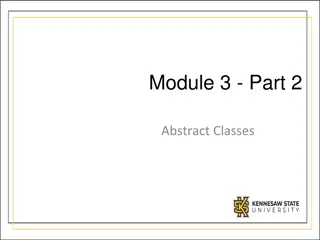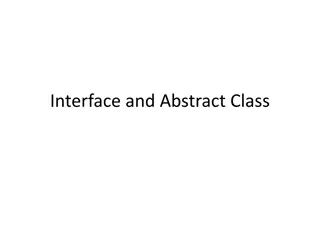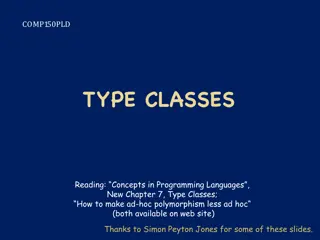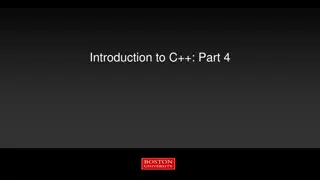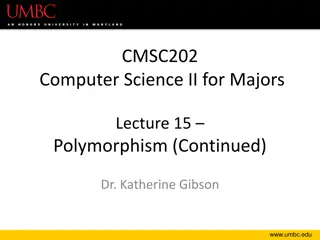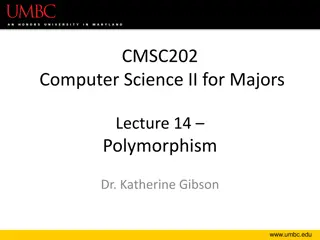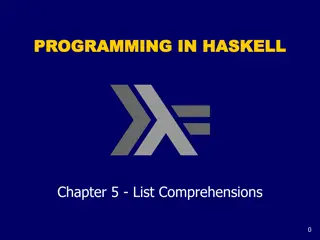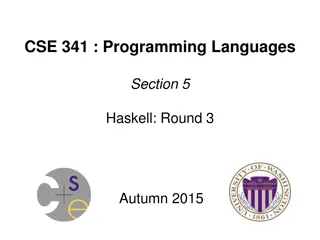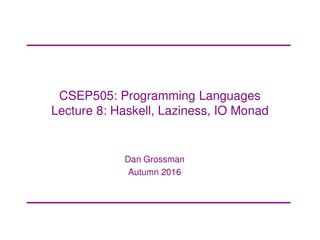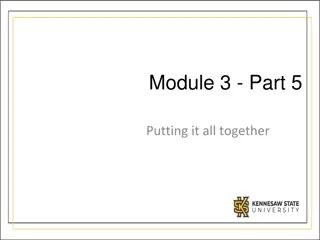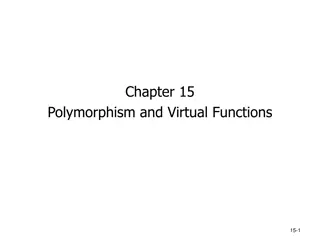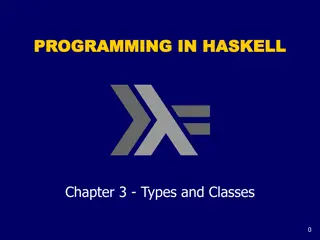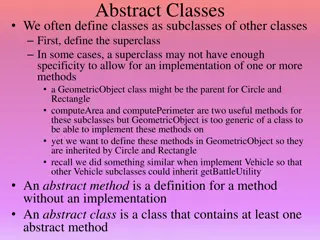Understanding Haskell Types, Classes, Functions, and Polymorphism
In Haskell, types are collections of related values, ensuring type safety through compile-time type inference. Type errors occur when functions are applied to arguments of the wrong type. Annotations help define types, and Haskell offers basic types like Bool, Char, String, Int, Integer, Float, and more. Lists in Haskell contain values of the same type, and composite types are built using type constructors. Dive into the world of Haskell type systems to enhance your programming skills.
Download Presentation

Please find below an Image/Link to download the presentation.
The content on the website is provided AS IS for your information and personal use only. It may not be sold, licensed, or shared on other websites without obtaining consent from the author. Download presentation by click this link. If you encounter any issues during the download, it is possible that the publisher has removed the file from their server.
E N D
Presentation Transcript
Shell CSCE 314 TAMU CSCE 314: Programming Languages Dr. Dylan Shell Haskell Types, Classes, and Functions, Currying, and Polymorphism 1
Shell CSCE 314 TAMU Types A type is a collection of related values. For example, Bool contains the two logical values True and False Int contains values 229, , 1, 0, 1, , 229 1 If evaluating an expression e would produce a value of type t, then e has type T, written e :: T Every well formed expression has a type, which can be automatically calculated at compile time using a process called type inference. 2
Shell CSCE 314 TAMU Type Errors Applying a function to one or more arguments of the wrong type is called a type error. 1 is a number and False is a logical value, but + requires two numbers. > 1 + False Error Static type checking: all type errors are found at compile time, which makes programs safer and faster by removing the need for type checks at run time. 3
Shell CSCE 314 TAMU Type Annotations Programmer can (and at times must) annotate expressions with type in the form For example, True :: Bool 5 :: Int -- type is really (Num t) => t (5 + 5) :: Int -- likewise (7 < 8) :: Bool Some expressions can have many types, e.g., 5 :: Int, 5 :: Integer, 5 :: Float GHCi command :type e shows the type of (the result of) e e :: T > not False True > :type not False not False :: Bool 4
Shell CSCE 314 TAMU Basic Types Haskell has a number of basic types, including: - logical values Bool - single characters Char - lists of characters type String = [Char] String - fixed-precision integers Int - arbitrary-precision integers Integer Float - single-precision floating-point numbers Double - double-precision floating-point numbers 5
Shell CSCE 314 TAMU List Types A list is sequence of values of the same type: [False,True,False] :: [Bool] [ a , b , c ] :: [Char] abc :: [Char] [[True, True], []] :: [[Bool]] Note: [t] has the type list with elements of type t The type of a list says nothing about its length The type of the elements is unrestricted Composite types are built from other types using type constructors Lists can be infinite: l = [1..] 6
Shell CSCE 314 TAMU Tuple Types A tuple is a sequence of values of different types: (False,True) :: (Bool,Bool) (False, a ,True) :: (Bool,Char,Bool) ( Howdy ,(True,2)) :: ([Char],(Bool,Int)) Note: (t1,t2, ,tn) is the type of n-tuples whose i-th component has type ti for any i in 1 n The type of a tuple encodes its size The type of the components is unrestricted Tuples with arity one are not supported: (t) is parsed as t, parentheses are ignored 7
Shell CSCE 314 TAMU Function Types A function is a mapping from values of one type (T1) to values of another type (T2), with the type T1 -> T2 not :: Bool -> Bool isDigit :: Char -> Bool toUpper :: Char -> Char (&&) :: Bool -> Bool -> Bool Note: add :: (Int, Int) Int add (x,y) = x+y zeroto :: Int [Int] zeroto n = [0..n] The argument and result types are unrestricted. Functions with multiple arguments or results are possible using lists or tuples: Only single parameter functions! 8
Shell CSCE 314 TAMU Curried Functions Functions with multiple arguments are also possible by returning functions as results: add :: (Int,Int) Int add (x,y) = x+y add takes an int x and returns a function add x. In turn, this function takes an int y and returns the result x+y. add :: Int (Int Int) add x y = x+y Note: add and add produce the same final result, but add takes its two arguments at the same time, whereas add takes them one at a time Functions that take their arguments one at a time are called curried functions, celebrating the work of Haskell Curry on such functions. 9
Shell CSCE 314 TAMU Functions with more than two arguments can be curried by returning nested functions: mult :: Int (Int (Int Int)) mult x y w = x*y*w mult takes an integer x and returns a function mult x, which in turn takes an integer y and returns a function mult x y, which finally takes an integer w and returns the result x*y*w Note: Functions returning functions: our first example of higher-order functions Unless tupling is explicitly required, all functions in Haskell are normally defined in curried form 10
Shell CSCE 314 TAMU Why is Currying Useful? Curried functions are more flexible than functions on tuples, because useful functions can often be made by partially applying a curried function. add 1 :: Int -> Int take 5 :: [a] -> [a] drop 5 :: [a] -> [a] For example: map map f map f (x:xs) :: (a->b) -> [a] -> [b] = [] f x : map f xs [] = > map (add 1) [1,2,3] [2,3,4] 11
Shell CSCE 314 TAMU Currying Conventions To avoid excess parentheses when using curried functions, two simple conventions are adopted: 1. The arrow (type constructor) associates to the right. Int Int Int Int Means Int (Int (Int Int)) 1. As a consequence, it is then natural for function application to associate to the left. mult x y z Means ((mult x) y) z 12
Shell CSCE 314 TAMU Polymorphic Functions A function is called polymorphic ( of many forms ) if its type contains one or more type variables. Thus, polymorphic functions work with many types of arguments. id :: a a length :: [a] Int for any type a, id maps a value of type a to itself for any type a, length takes a list of values of type a and returns an integer head :: [a] a take :: Int [a] [a] a is a type variable 13
Shell CSCE 314 TAMU Polymorphic Types Type variables can be instantiated to different types in different circumstances: a = Bool > length [False,True] 2 > length [1,2,3,4] 4 a = Int Type variables must begin with a lower-case letter, and are usually named a, b, c, etc. 14
Shell CSCE 314 TAMU More on Polymorphic Types What does the following function do, and what is its type? twice :: (t -> t) -> t -> t twice f x = f (f x) > twice tail abcd cd What is the type of twice twice? The parameter and return type of twice are the same (t -> t) Thus, twice and twice twice have the same type So, twice twice :: (t -> t) -> t -> t 15
Shell CSCE 314 TAMU Overloaded Functions A polymorphic function is called overloaded if its type contains one or more class constraints. for any numeric type a, sum takes a list of values of type a and returns a value of type a sum :: Num a [a] a Constrained type variables can be instantiated to any types that satisfy the constraints: > sum [1,2,3] 6 > sum [1.1,2.2,3.3] 6.6 > sum [ a , b , c ] ERROR a = Int a = Float Char is not a numeric type 16
Shell CSCE 314 TAMU Class Constraints Recall that polymorphic types can be instantiated with all types, e.g., id :: t -> t length :: [t] -> Int This is when no operation is subjected to values of type t What are the types of these functions? min :: Ord a => a -> a -> a min x y = if x < y then x else y elem :: Eq a => a -> [a] -> Bool elem x (y:ys) | x == y = True elem x (y:ys) = elem x ys elem x [] = False 17
Shell CSCE 314 TAMU Class Constraints Recall that polymorphic types can be instantiated with all types, e.g., id :: t -> t length :: [t] -> Int This is when no operation is subjected to values of type t What are the types of these functions? min :: Ord a => a -> a -> a min x y = if x < y then x else y Type variables can only be bound to types that satisfy the constraints elem :: Eq a => a -> [a] -> Bool elem x (y:ys) | x == y = True elem x (y:ys) = elem x ys elem x [] = False Ord a and Eq a are class constraints 18
Shell CSCE 314 TAMU Type Classes Constraints arise because values of the generic types are subjected to operations that are not defined for all types: min :: Ord a => a -> a -> a min x y = if x < y then x else y elem :: Eq a => a -> [a] -> Bool elem x (y:ys) | x == y = True elem x (y:ys) = elem x ys elem x [] = False Ord and Eq are type classes: Num (Numeric types) Eq (Equality types) Ord (Ordered types) (+) :: Num a a a a (==) :: Eq a a a Bool (<) :: Ord a a a Bool 19
Shell CSCE 314 TAMU Haskell 98 Class Hierarchy -- For detailed explanation, refer to http://www.haskell.org/onlinereport/basic.html 20
Shell CSCE 314 TAMU The Eq and Ord Classes class where :: = not (x == y) = not (x /= y) (Eq a) => Ord a compare :: a -> a -> Ordering (<), (<=), (>=), (>) :: a -> a -> Bool max, min :: a -> a -> a Eq a (==), (/=) x /= y x == y class a -> a -> Bool x <= y = compare x y /= GT x < y = compare x y == LT x >= y = compare x y /= LT x > y = compare x y == GT where max x y | x <= y = y x x y | otherwise = min x y | x <= y = compare x y | x == y = EQ = LT | otherwise = | x <= y | otherwise = GT 21
Shell CSCE 314 TAMU The Eq and Ord Classes class where :: = not (x == y) = not (x /= y) (Eq a) => Ord a compare :: a -> a -> Ordering (<), (<=), (>=), (>) :: a -> a -> Bool max, min :: a -> a -> a Eq a (==), (/=) x /= y x == y class a -> a -> Bool x <= y = compare x y /= GT x < y = compare x y == LT x >= y = compare x y /= LT x > y = compare x y == GT where max x y | x <= y = y x x y | otherwise = min x y | x <= y = compare x y | x == y = EQ = LT | otherwise = | x <= y | otherwise = GT 22
Shell CSCE 314 TAMU The Show and Read Classes class Show a where show :: a -> String class Read a where read :: String -> a Many types are showable and/or readable. > show 10 10 > show [1,2,3] [1,2,3] > read 10 :: Int 10 > read ( [1,2,3] ) :: [Int] [1,2,3] > map (* 2.0) (read [1,2] ) [2.0,4.0] 23
Shell CSCE 314 TAMU Hints and Tips When defining a new function in Haskell, it is useful to begin by writing down its type. Within a script, it is good practice to state the type of every new function defined. When stating the types of polymorphic functions that use numbers, equality or orderings, take care to include the necessary class constraints. 24
Shell CSCE 314 TAMU Exercises What are the types of the following values? (1) [ a , b , c ] ( a , b , c ) [(False, 0 ),(True, 1 )] ([False,True],[ 0 , 1 ]) [tail,init,reverse] 25
Shell CSCE 314 TAMU What are the types of the following functions? (2) second xs = head (tail xs) swap (x,y) = (y,x) pair x y = (x,y) double x = x*2 palindrome xs = reverse xs == xs lessThanHalf x y = x * 2 < y Check your answers using GHCi. (3) 26
Shell CSCE 314 TAMU second :: [a] -> a second xs = head (tail xs) swap :: (a, b) -> (b, a) swap (x,y) = (y,x) pair :: a -> b -> (a, b) pair x y = (x,y) double :: Num a => a -> a double x = x*2 palindrome :: Eq a => [a] -> Bool palindrome xs = reverse xs == xs lessThanHalf :: (Num a, Ord a) => a -> a -> Bool lessThanHalf x y = x * 2 < y 27
Shell CSCE 314 TAMU second :: [a] -> a second xs = head (tail xs) swap :: (a, b) -> (b, a) swap (x,y) = (y,x) pair :: a -> b -> (a, b) pair x y = (x,y) double :: Num a => a -> a double x = x*2 palindrome :: Eq a => [a] -> Bool palindrome xs = reverse xs == xs lessThanHalf :: (Num a, Ord a) => a -> a -> Bool lessThanHalf x y = x * 2 < y 28
Shell CSCE 314 TAMU The Eq and Ord Classes class where :: = not (x == y) = not (x /= y) (Eq a) => Ord a compare :: a -> a -> Ordering (<), (<=), (>=), (>) :: a -> a -> Bool max, min :: a -> a -> a Eq a (==), (/=) x /= y x == y class a -> a -> Bool x <= y = compare x y /= GT x < y = compare x y == LT x >= y = compare x y /= LT x > y = compare x y == GT where max x y | x <= y = y x x y | otherwise = min x y | x <= y = compare x y | x == y = EQ = LT | otherwise = | x <= y | otherwise = GT 29
Shell CSCE 314 TAMU The Enum Class class Enum a where :: Int -> a :: a -> Int toEnum fromEnum succ, pred :: a -> a . . . -- Minimal complete definition: toEnum, fromEnum Note: these methods only make sense for types that map injectively into Int using fromEnum and toEnum. succ pred = = toEnum . (+1) . fromEnum toEnum . (subtract 1) . fromEnum 30


